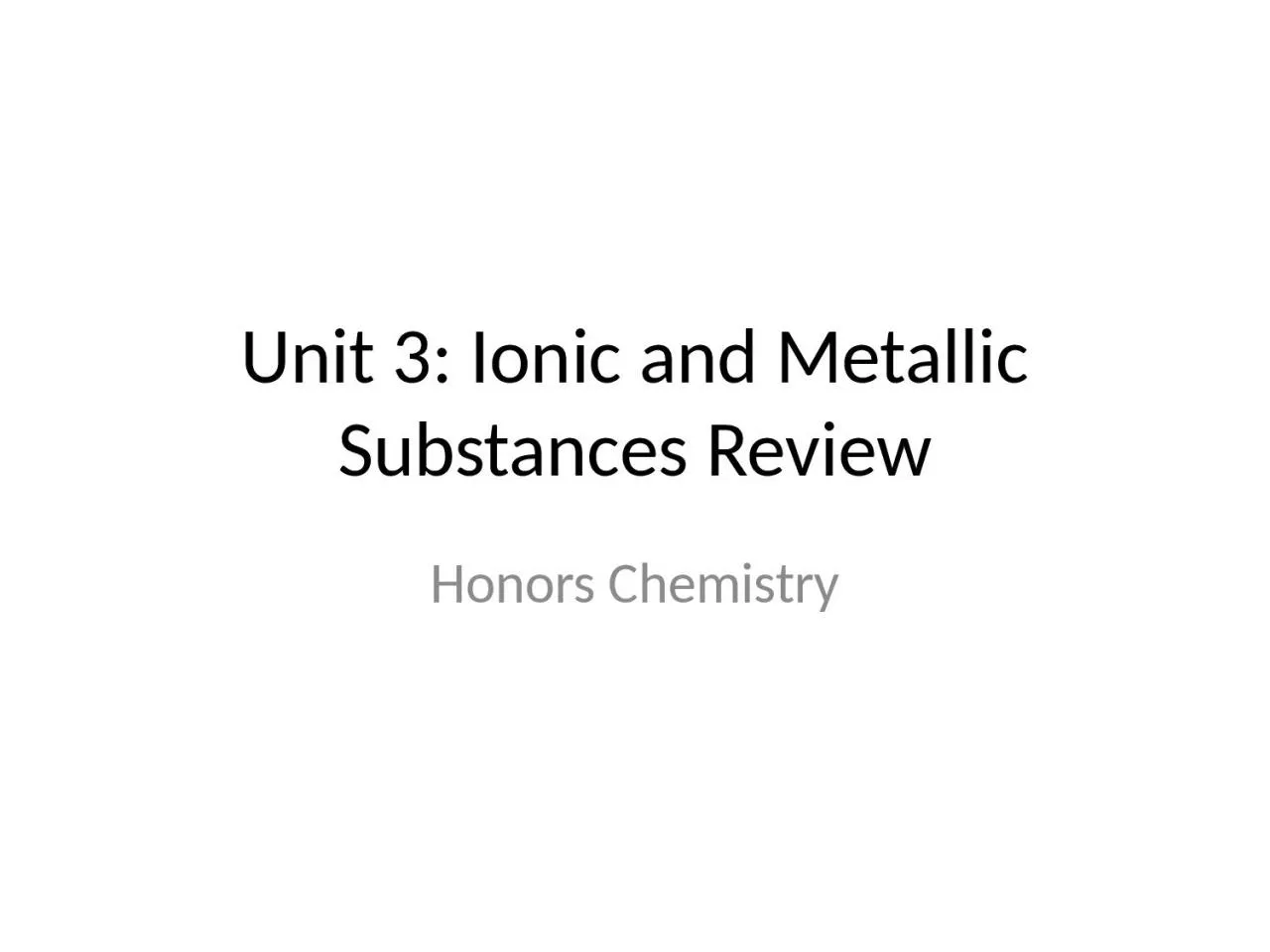

Honors Chemistry 1 Which of the following is ionic NF 3 HCl CuCl 2 CO 2 2 Which of the following is covalent MgO H 3 N FeO ZnCl 3 To form an ion Nitrogen will Lose 3 electrons to become N ID: 931429
Download Presentation The PPT/PDF document "Unit 3: Ionic and Metallic Substances Re..." is the property of its rightful owner. Permission is granted to download and print the materials on this web site for personal, non-commercial use only, and to display it on your personal computer provided you do not modify the materials and that you retain all copyright notices contained in the materials. By downloading content from our website, you accept the terms of this agreement.
Slide1
Unit 3: Ionic and Metallic Substances Review
Honors Chemistry
Slide21. Which of the following is ionic?
NF
3
HClCuCl2CO2
Slide32. Which of the following is covalent?
MgO
H
3NFeOZnCl
Slide43. To form an ion Nitrogen will
Lose 3 electrons to become N
3-
Lose 3 electrons to become N3+Gain 3 electrons to become N3-
Gain 3 electrons to become N
3+
Slide54. To form an ion K will
Lose 1 electron to become K
-
Lose 1 electron to become K+Gain 1 electron to become K-
Gain 1 electron to become
K
+
Slide65. What is the correct name for CaCl
2
?
calcium chloridecalcium dichloridemonocalcium dichloride
calcium (I) chloride
calcium (II) chloride
Need help with naming?
Watch this.
Slide76. What is the correct name for CuCl
2
?
copper chloridecopper dichloridemonocopper dichloride
copper (I) chloride
copper (II) chloride
Need help with naming?
Watch this.
Slide87. What is the correct name for
NaOH
?
sodium oxygen hydridesodium hydroxideSodium monooxygen monohydride
sodium (I) hydroxide
sodium (II) hydroxide
Need help with naming?
Watch this.
Slide98. What is the correct name for NH
4
Cl?
nitrogen tetrahydrogen chloridenitrogen (I) tetrahydrogen chloride
a
mmonium chloride
a
mmonium (I) chloride
Need help with naming?
Watch this.
Slide109. What is the correct name for FeC
2
H
3O2?iron carbon hydrogen oxideiron (I) carbon hydrogen oxide
Iron (I)
dicarbon
tri hydrogen dioxide
iron (I) acetate
Need help with naming?
Watch this.
Slide1110. What is the correct formula for magnesium oxide?
Mg
2
O2MgOMgO2
Mg
2
O
Need help with naming?
Watch this.
Slide1211. What is the correct formula for mercury (II) sulfite?
HgSO
3
HgSO4Hg2(SO3)
2
Hg(SO
3
)
2
Need help with naming?
Watch this.
Slide1312. What is the correct formula for iron (III) oxide?
FeO
Fe
2O3Fe3O2
Fe(OH)
3
Need help with naming?
Watch this.
Slide1413. What is true about electrons in ionic bonds?
Electrons are shared equally
Electrons are shared unequally
Electrons are transferred from the metal to the nonmetalElectrons are transferred from the nonmetal to the metal
Electrons move freely in in a “sea of electrons
Slide1514. What is true about electrons in nonpolar covalent bonds?
Electrons are shared equally
Electrons are shared unequally
Electrons are transferred from the metal to the nonmetalElectrons are transferred from the nonmetal to the metal
Electrons move freely in in a “sea of electrons
Slide1615. What is true about electrons in polar covalent bonds?
Electrons are shared equally
Electrons are shared unequally
Electrons are transferred from the metal to the nonmetalElectrons are transferred from the nonmetal to the metal
Electrons move freely in in a “sea of electrons
Slide1716. What is true about electrons in metallic bonds?
Electrons are shared equally
Electrons are shared unequally
Electrons are transferred from the metal to the nonmetalElectrons are transferred from the nonmetal to the metal
Electrons move freely in in a “sea of electrons
Slide1817. Why is it incorrect to call
NaCl
a molecule?
Molecules contain more than two atomsMolecules occur between a metal/nonmetalMany ions of Na+ and
Cl
-
exist in a crystal lattice
One ion of Na
+
and
Cl
-
have an ionic bond
The sodium ion forms a metallic bond with other sodium ions
Slide1917. What is the general trend of electronegativity on the periodic table?
Electronegativity decreases as you move to the left and up
Electronegativity decreases as you move to the right and down
Electronegativity decreases as you move to the left and down
Electronegativity decreases as you move to the right and up
Slide2017. Which is more electronegative, carbon, nitrogen, sulfur or phosphorus?
carbon
nitrogen
sulfurphosphorus
Slide2118. Fill out this table with formulas
K
Ca
Cr (III)
Pb
(IV)
Br
CO
3
2-
N
PO
4
3-
Slide2218. Fill out this table with formulas
K
Ca
Cr (III)
Pb
(IV)
Br
KBr
CaBr
2
CrBr
3
PbBr
4
CO
3
2-
K
2
CO
3
CaCO
3
Cr
2
(CO
3
)
3
Pb
(CO
3
)
2
N
K
3
N
Ca
3
N
2
CrN
Pb
3
N
4
PO
4
3-
K
3
PO
4
Ca
3
(PO
4
)
2
CrPO
4
Pb
3
(PO
4
)
4
Slide2319.
For K
and S: a.) draw the electron dot structure b.) show the transfer of electrons to form ionsc.) draw the resulting ionsd.) write the formula of the compound they form
K
.
S
.
.
.
.
.
.
K
.
..
2K
+
+
S
2-
K
2
S
..
..
.
.